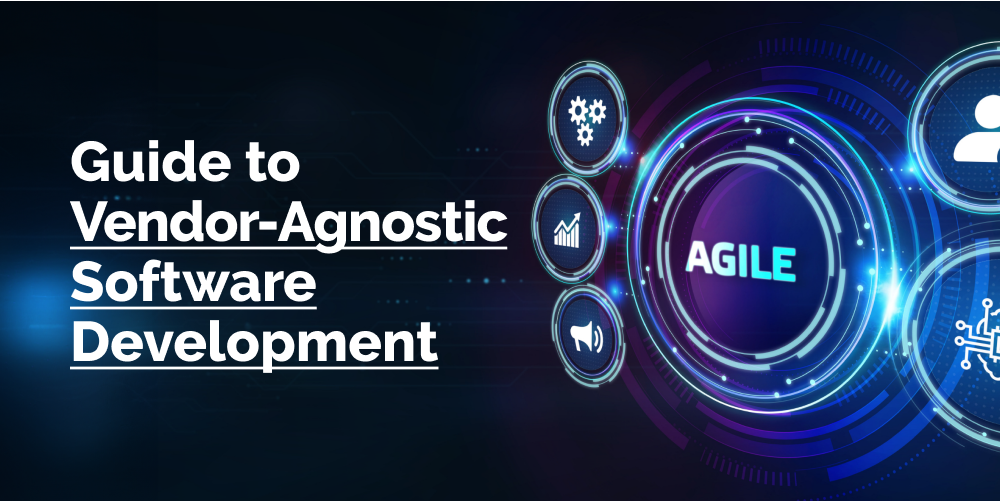Software Development, zBlog
Vendor Agnostic Software Development: A Thought Leadership Guide
Team Trantor | Updated: January 17, 2024
Introduction
Vendor lock-in. It’s a phrase that haunts CTOs and CIOs trying to navigate complex technology landscapes dominated by a few major players. When organizations become overly reliant on proprietary software or technologies from dominant vendors, they risk losing bargaining power, flexibility, and ultimately the ability to adapt.
But what if you could develop key software capabilities in-house, leveraging whatever technologies make sense for the business, swapping vendors whenever better options emerge? This vendor-agnostic approach attempts to regain control through architecture guided by modular design principles, platform independence, and avoiding vendor proprietary code or APIs.
The benefits promise to be immense. Architecting for multi-vendor compatibility means software investments transcend the fate or whims of any single provider. Applications live on even after rip-and-replace technology upgrades. Switching vendors spurs competition which keeps costs in check. Preventing dominant vendor lock-in restores leverage to the customer, enabling you to create best-of-breed technology stacks cherry-picked from diverse suppliers.
This guide offers CIOs, CTOs, architects, and technical leaders key considerations for pursuing adaptive, vendor-neutral software development strategies built for continual change.
Defining Vendor-Agnostic Development

Vendor-agnostic development aims to architect portable and replaceable solutions spanning many underlying components or services supplied by an ecosystem of vendors. The core design principle focuses on avoiding reliance on proprietary implementations while enabling flexibility and interoperability across vendors.
Contrast this with the common alternative of vendor-specific development stacks fueling dominant platform lock-in. This typically involves extensive leveraging of proprietary code, APIs, data formats, and architectural constraints that restrict choice and prevent mixing and matching alternative suppliers. Assumptions about underlying technologies get implicitly baked into the software, obstructing extensibility.
Vendor-agnostic development closely relates to open standards which offer vendor-neutral specifications to promote compatibility. However, adherence to formal standards is not a prerequisite. Vendor agnosticism simply requires that internal designs refrain from specificity to enable choice where possible. This future-proofs software investments against changes in technology supply markets.
The Business Benefits

Why does escaping vendor dominance matter so much in modern software development? What compelling business outcomes beyond buzzwords like “flexibility” emerge from vendor-neutral architectures?
Avoiding Vendor Lock-In Risks
Over-reliance on specific vendors inserts risks should relationships sour, licensing prove unfavorable, mergers trigger instability, or providers exert monopoly power over pricing. Vendor-agnostic design protects leverage.
Enabling Best-of-Breed Technology Stacks
No single vendor offers superior solutions across all domains. Multi-vendor compatibility allows organizations to integrate preferred point solutions into optimal stacks.
Cost Savings Through Ongoing Competition
Architectures portable across equivalent vendor services inspire ongoing market competition even after initial selections, avoiding monopoly price hikes.
Accelerating Innovation Through Interoperability
Openness to easily swap between a range of vendor technologies also lowers the barriers to adopting innovative developments as they emerge across the industry.
The Architectural Paradigm Shift

But how does vendor agnosticism translate architecturally? What shifts must occur in design thinking to enable durable extensibility across technology supply chains subject to ongoing change?
Module Internal Architectures After Business Capabilities
Rather than building software reinforced around vendor product structures, analyze functional business capabilities. Deconstruct into self-contained modules encapsulating capability behaviors behind abstract interfaces. These modules integrate using enterprise patterns to create services inventory accessible across vendors.
Design Portability of Data and Interoperability Contracts
Aiming for portability across equivalent vendor solutions requires carefully handling potentially proprietary data schemas, APIs, and conventions baked into traditional vendor packages. Adopt capability-focused information models independent from underlying providers, with adapters routing across vendors.
Plan For Multi-Cloud Through Infrastructure Abstraction
Model infrastructure dependencies using abstractions such as virtual machines, containers, resource quantities, and locations rather than vendor-specific facilities. This lifts modules away from inherent platform constraints that prevent portable deployments.
Develop Without Vendor Lock-In Triggers
Vendor technologies benefit solutions but require strategic usage without enabling creeping lock-in. Scrutinize provider packages. Encapsulate proprietary code, data models, or resource dependencies behind open façades or alternative implementations allowing portable replacements.
The Quest for Truly Agile Development

Legacy monoliths paralyze innovation, demanding unrelenting maintenance. But modular architectures with capabilities decoupled from underlying technologies establish the foundation for genuine agility – adapting to every market force through configurable best-of-breed solutions. Vendor-agnostic principles pioneer the path to strategic optionality.
Implementation Strategies

Maturing from vendor-centric application structures to capability-focused services calls for adopting new design patterns and integration architectures. Strategies for avoiding dominant platform assumptions underly success.
Decompose Monoliths into Microservices Mapped to Capabilities
Analyze existing business functions within legacy platforms and deconstruct them into standalone microservices. These capability services strictly encapsulate proprietary dependencies behind open interfaces mediating modular intercommunication.
Wrap Vendor Packages and Proprietary Code in Open Interfaces
When benefiting from vendor package capabilities and tools, avoid leakage of specificity by wrapping integrations behind simple abstraction layers at capability boundaries. This isolates external reliance to allow replacements.
Leverage Enterprise Integration Patterns For Vendor Interoperation
Over time accumulated interfaces from wrapped microservices and capabilities converge on enterprise integration architectures mediated through lightweight message brokers like Apache Kafka or brokerless patterns aligned reactive systems. Focus all coordination through vendor-agnostic channels.
Custom Develop Integrations Independent of Vendors
When no existing vendor solutions sufficiently satisfy capability needs, build custom software directly conforming to internal domain models controlled entirely independently of outside platforms. Completely owning these inner capability modules is essential for avoiding external vendor dominance. They integrate like any other component behind capability interfaces.
The Ever Continuing Challenge

Swappable as technology supply markets shift. But seamless integration of cross-vendor technologies presents no shortage of challenges…
Managing the Complexity of Abstraction Layers and Translations
Multi-vendor interoperation requires intermediate abstractions adding complexity to data models. The layers of translation bloat technical debt jeopardizing agility goals long term. Architectural oversight and governance grow in intensity.
The Perennial Testing Burden in Heterogeneous Environments
More moving parts equate to more permutations to validate each change. Testing resource overhead multiplies in loosely coupled landscapes. Achieving comprehensive regression coverage requires test automation mastery.
Herding More Vendor Relationships
Each commercial external component drags procurement processes, legal agreements, vendor account management, and technical support channels. Hand-holding diverse providers has personnel impacts that can overwhelm enterprise architects. Consider outsourcing oversight where possible.
Final Thoughts
The dynamics of today’s software technology industry incentivize consolidation and vendor dominance, jeopardizing customer choice. Organizations can regain leverage by forgoing monolithic platforms that dominate enterprise technology decisions. Instead, architecting for capability-based modularity guided by principles of vendor independence opens the possibility for continually optimizable solutions.
No single vendor reigns superior across all capability domains. Nor do they maintain dominance permanently as innovation cycles through supply markets. Vendor-agnostic development unravels false dependencies, restoring leverage to choose best-of-breed component solutions based on evolving business priorities rather than long-term technology bets.
Architecting for optionality requires relinquishing outdated vendor-centric legacies that dominate, instead opening integration points through modular facade interfaces to enable interchangeability of underlying components. This places the business in the driver’s seat, positioning technology roadmaps to adapt boldly to whatever opportunities appear on the horizon.
The future awaits those who align solutions to business capabilities, not vendors – innovating through rapidly reconfigurable modules and microservices drawn from vibrant multi-provider ecosystems interchangeably woven together as needs arise. With vendor-dominant platform assumptions defeated, the stage is set for agility at last through a truly future-proof modular architecture.
Conclusion: Embracing Trantor’s Expertise in Vendor-Agnostic Software Development
In the ever-evolving landscape of software development, where the pursuit of agility and vendor independence is paramount, partnering with a seasoned expert like Trantor becomes a strategic imperative. Trantor, a leader in software development and outsourced software solutions, stands at the forefront of the industry, ready to empower organizations with innovative approaches and scalable solutions.
As organizations navigate the complexities of vendor lock-in and seek to build adaptable, future-proof software ecosystems, Trantor’s expertise shines through. With a profound understanding of the principles outlined in this guide, Trantor champions a vendor-agnostic approach, leveraging modular design principles, open standards, and a commitment to avoiding proprietary dependencies.
Trantor’s Captive CoE (Center of Excellence) engagement model emerges as a powerful catalyst for scaling tech teams and fostering long-term success. This model aligns with the principles of vendor-agnostic product development and goes a step further by establishing a dedicated, in-house team that seamlessly integrates with your organization’s culture and objectives. This ensures a deep understanding of your business requirements and allows for creating of tailored, adaptable solutions.
By embracing Trantor’s expertise, organizations can liberate themselves from the shackles of vendor dominance, ushering in a new era of flexibility, innovation, and strategic optionality. Trantor’s commitment to vendor-agnostic development aligns seamlessly with the principles discussed in this guide, offering a path to building software capabilities that transcend the limitations of any single provider.
In conclusion, as you embark on the journey of architecting vendor-agnostic software solutions and scaling your tech teams, consider Trantor your trusted partner. With a proven track record in outsourced software development and a commitment to the CaptiveCoE™ engagement model, Trantor stands ready to guide your organization toward a future where adaptability and excellence define your technological landscape.





